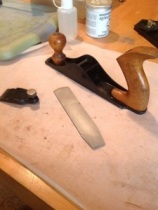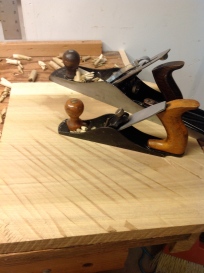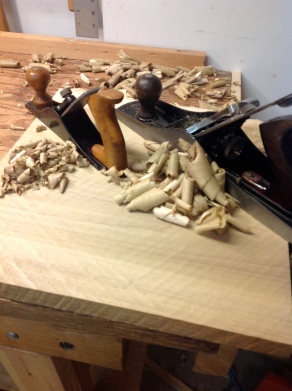Scrub Plane vs Fore Plane
It’s cold today with fresh snow on the ground making it brighter and more cheerful outside. I’m struggling with a cold of my own so instead of heading out to the garage I have been sharpening and cleaning tools. I have been using a Stanley #6 for rough work. It is hefty and feels good in my hands and it quickly brings a delinquent board under control. The blade is cambered to an 8″ radius and it does not get sharpened very often, but today the blade sparkles with a new edge.
 I cleaned and sharpened one of the planes that my Father in Law dropped off, a Stanley #40. It is in great shape and I particularly like the beech handles, the color stands out boldly against the black Japanning.
I cleaned and sharpened one of the planes that my Father in Law dropped off, a Stanley #40. It is in great shape and I particularly like the beech handles, the color stands out boldly against the black Japanning.
I was surprised when he handed me the plane because it is quite small and quite the opposite of the hefty #6. The blade has a camber that must be closer to 3″ and is in excellent condition. I sharpened both it and my fore plane because I wanted to understand where each tool would fit into my work and the best way I know to do that is to put them to work.
Digging through my scrap box I came a cross a piece of poplar that would serve my purpose and dogged it down on the bench. The scrub plane took bold cuts diagonally across the board leaving gouges that are typical of the heavily cambered blade. I worked about 1/3 of the way across the board and into an area that I new was cupped. The plane kept moving material across the board with no hesitation. Next picking up the fore plane I finished taking cuts across the board. It wasn’t long until I noticed that the cup in the middle of the board was deep enough for the longer plane to bridge across and only shave the two edges of the board.

If you look in the picture below you can see the change in color of the wood where I stopped using the scrub plane and switched to the fore plane. So I sat down on the old 5 gallon bucket to think. If you have read my blog you’ll notice that I use the bucket quite a bit, one day when I find the right plans I will be sitting down on a stool, but for now the 5 gallon bucket will have to do. The planes have done exactly what you would expect. The longer bed of the fore plane allows it to bridge across the undulations of the wood and work to flatten the entire board. The shorter scrub plane only bridges a very short distance,so in the case of this board it has done a fabulous job of shaving the thickness of the board but as for flattening, i’m not so sure. Adjusting the blade depth would certainly make a difference, as would changing the camber of the blade.
The heavier fore plane is a beast when it comes to “hogging’ waste and once moving it is difficult to stop, exactly what I want when trying to level and thickness a board, but I think for narrower boards and smaller work the scrub plane has a place. I’ll keep trying it in different situations and refining its place in my tool box. In the mean time enjoy the photo of the different shavings and certainly the color of the tote gives it a striking appearance. If you have thoughts on these planes please comment there’s a lot to learn.


Love those shavings! It’s always fun to see what is a scrap to one person can become in another’s hands.
I mainly use power tools, but dabble with my hand tools…but truly appreciate hand tool work. I ordered a shoulder plane and router plane the other day which will help with my fine tuning of joints when the power tools need help.
Keep up the good work.
The reason I wanted a scrub plane is because I was using my Stanley #5 for removing large amounts of wood and while it could do the job it just took waayyy longer that it should have. When I finally got one (on Christmas Day) I found it definitely does the job better than a jack plane but I also found that it is a little harder to control due to its lighter weight and smaller size. Also I think it takes a bit more practice, especially on edges of boards. I recently used it to remove about 3/16″ off the edge of a 36″ long and 3/4″ thick board and it resulted in very inconsistent results, which were the fault of me not the plane. Happy planing!
For removing a lot of wood when thicknessing a board or correcting any significant unevenness the scrub plane is my tool of choice. You can take big, chunky chips off with it easily – especially working diagonally or directly across the board.
I used it to level the rough faces of the glue-up for my workbench top. I used three salvaged 6 x 9 doug fir timbers. I jointed the glue faces first of course, but left flattening the other surfaces until after the glue-up was complete. I was able to level the entire tip pretty quickly with the #40. It’s also a lot less effort then a #6 or #8 to use. I followed up the #40 with my #8, which is a real workout.
This is a picture of it in use flattening the bench top:

Bob, I’m looking forward to full time shop work with planes and all — they’re fascinating to use! Seeing your post and remarks about your 5 gallon bucket reminded me of my “thinking stool”. Here’s a link to it, ever consider trying to weave a seat?, it too is a fascinating process! https://woodworksbyjohn.com/2013/12/19/2-x-4-x-8-challenge-december-2013-sin-city-woodworkers/